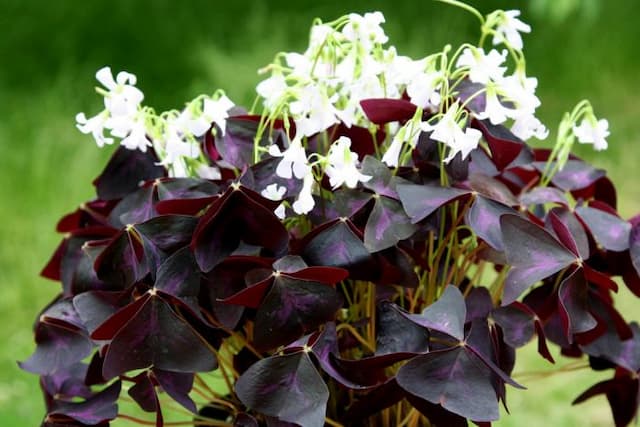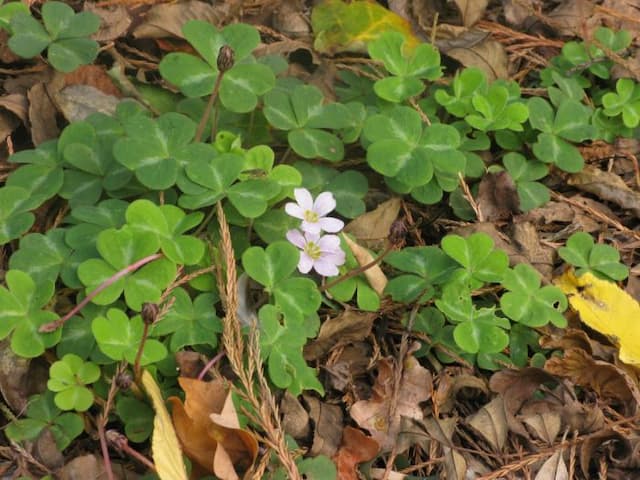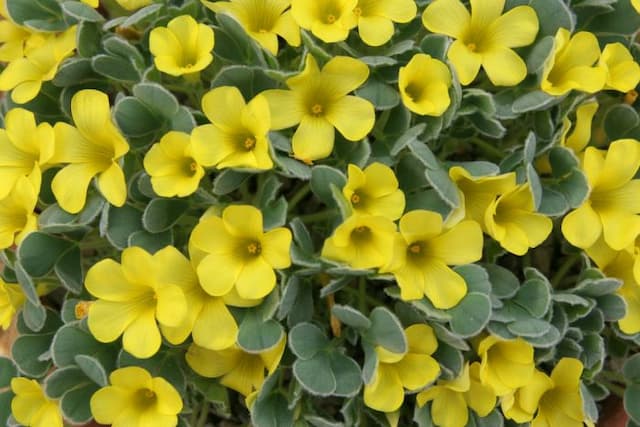Scurvy Grass Sorrel Oxalis enneaphylla 'Rosea'

ABOUT
Oxalis enneaphylla 'Rosea', commonly known as the pink wood sorrel, is a charming flowering perennial notable for its attractive foliage and delicate blooms. The leaves of this plant are clover-like in appearance, typically consisting of three or more heart-shaped leaflets that emerge from a single point, creating a symmetrical whorl. These leaflets are a rich green, sometimes with a slightly glaucous or silvery overlay that gives a frosted effect. The most striking feature of the pink wood sorrel is its flowers. The blooms are a soft, rose-pink color, presenting a gentle contrast to the foliage. Each flower consists of five petals that are radially arranged around a central point, producing a cupped, open shape. The petals can be described as having a satiny sheen and may display delicate veining, which adds depth and texture to their appearance. Additionally, this plant has a compact, clumping habit, creating a neat and tidy presentation in garden settings. It often forms dense mounds of foliage from which the slender flower stalks arise, with the flowers sitting just above the leaves, giving a floating effect. The overall appearance of the pink wood sorrel is one of softness and delicacy, with a color palette that is both soothing and visually appealing. This inviting aspect makes it a popular choice for rock gardens, alpine displays, and as an ornamental accent in mixed flower borders.
About this plant
 Names
NamesFamily
Oxalidaceae.
Synonyms
Scurvy Grass, Pink-eyed Oxalis, Pink Wood Sorrel.
Common names
Oxalis purpurata, Acetosella enneaphylla, Ionoxalis enneaphylla.
 Toxicity
ToxicityTo humans
The plant in question is commonly known as the Scurvy Grass. Generally, Oxalis species contain oxalic acid, which can be toxic to humans when ingested in large quantities. Oxalic acid can bind to calcium in the body, leading to the formation of calcium oxalate crystals, which can cause kidney stones. Ingesting small amounts is usually not harmful, but consuming large amounts can lead to symptoms such as nausea, vomiting, diarrhea, abdominal pain, and even kidney damage in severe cases. It is important to handle Scurvy Grass with care and avoid consuming it in large amounts to prevent possible toxic effects.
To pets
The Scurvy Grass is also considered toxic to pets because it contains oxalic acid. In pets like dogs and cats, ingestion of significant amounts of this plant can lead to similar symptoms as in humans, such as vomiting, diarrhea, drooling, loss of appetite, or abdominal pain. In severe cases, particularly if large quantities are ingested, it may result in kidney damage or even kidney failure. Therefore, it’s essential to prevent pets from consuming any part of the Scurvy Grass and to seek veterinary attention if accidental ingestion is suspected.
 Characteristics
CharacteristicsLife cycle
Perennials
Foliage type
Evergreen
Color of leaves
Green
Flower color
Pink
Height
0.1 feet (3 cm)
Spread
0.5 feet (15 cm)
Plant type
Bulb
Hardiness zones
7
Native area
Patagonia
Benefits
 General Benefits
General Benefits- Ornamental Value: Oxalis enneaphylla 'Rosea', commonly known as Scurvy Grass, has attractive pink flowers that add aesthetic beauty to gardens and landscapes.
- Low Maintenance: Scurvy Grass is known for being hardy and requiring minimal care once established, making it suitable for gardeners of all skill levels.
- Cold Tolerance: This plant is capable of withstanding cold temperatures, which makes it suitable for cultivation in cooler climates or as a seasonal plant in temperate zones.
- Pollinator Attraction: The flowers of Scurvy Grass can attract beneficial insects like bees, which are essential for the pollination of many other plants.
- Ground Cover: With its spreading habit, Scurvy Grass can serve as a dense ground cover, helping to suppress weeds and stabilize soil.
- Edibility: The leaves of Scurvy Grass are edible and can be used in salads or as a garnish, offering a culinary use in the kitchen.
- Container Gardening: Its compact size makes it suitable for container gardening, allowing people with limited space to enjoy its beauty.
 Medical Properties
Medical PropertiesThis plant is not used for medical purposes.
 Air-purifying Qualities
Air-purifying QualitiesThis plant is not specifically known for air purifying qualities.
 Other Uses
Other Uses- Oxalis enneaphylla 'Rosea', commonly known as scurvy-grass sorrel, can be used as a natural dye, where the pigment can be extracted to produce colors for fabric or artwork.
- In small quantities, the leaves of scurvy-grass sorrel may be used to add a lemony flavor to salads and soups, much like a culinary herb, due to its sharp taste.
- The flowering plant can serve as an educational tool in botany or horticulture classes, illustrating plant adaptations to cold environments.
- As a decorative element, the flowers and leaves can be pressed and used in arts and crafts, like making bookmarks or greeting cards.
- The plant can be grown in containers for mobile gardening, making it ideal for people who live in apartments or have limited garden space.
- Scurvy-grass sorrel can be used in a terrarium setup, creating a miniature landscape to observe and maintain indoors.
- The vibrant flowers can be used in photography as a natural prop or backdrop to enhance the aesthetic appeal of close-up photos of insects or other small subjects.
- In areas with compatible climates, it can be employed for ground cover, reducing soil erosion and suppressing weed growth in gardens.
- During the off-season or when not in flower, the leaves of the scurvy-grass sorrel provide a green backdrop, supporting garden aesthetics when other plants are dormant.
- The plant can act as a natural barometer, as some believe it responds to atmospheric pressure changes and may close its flowers before onset of rain.
Interesting Facts
 Feng Shui
Feng ShuiThe Oxalis is not used in Feng Shui practice.
 Zodiac Sign Compitability
Zodiac Sign CompitabilityThe Oxalis is not used in astrology practice.
 Plant Symbolism
Plant Symbolism- Luck: As a member of the Oxalis family, commonly known as wood sorrels or false shamrocks, Oxalis enneaphylla 'Rosea' is often associated with good luck due to its resemblance to the four-leaf clover.
- Resilience: This plant is known for its ability to survive in harsh, cold climates, symbolizing the ability to endure difficult conditions and bounce back from adversity.
- Balance: The symmetrical arrangement of the leaves often embodies the concept of balance and harmony in life.
- Adaptability: Its capability to adapt to varying environments makes the Oxalis enneaphylla 'Rosea' a symbol of flexibility and the importance of adjusting to new situations.
 Water
WaterScurvy Grass Sorrel should be watered thoroughly, allowing the top inch of soil to dry out between waterings. The frequency of watering will vary with the environment, but generally, once every 7-10 days should suffice, depending on the humidity and temperature conditions. When watering, use room temperature water and provide enough water so that it runs through the drainage holes—approximately one quart for smaller pots. During dormant periods in winter, reduce watering to minimal, just enough to prevent the soil from completely drying out.
 Light
LightScurvy Grass Sorrel prefers bright, indirect light to partial shade. It should be placed in a spot where it can receive plenty of light but is shielded from the harsh, direct afternoon sun. A location near an east or west-facing window covered with a sheer curtain would be ideal to filter the light.
 Temperature
TemperatureScurvy Grass Sorrel thrives in temperatures between 50 and 75 degrees Fahrenheit and can tolerate minimum temperatures down to about 20 degrees Fahrenheit. The ideal growing conditions are cool, as it is native to Southern Argentina and the proximity of the cold Southern Ocean, so it prefers climates that do not exceed 75 degrees Fahrenheit. Ensure it is kept away from hot or cold drafts which can cause stress to the plant.
 Pruning
PruningScurvy Grass Sorrel may require occasional pruning to remove dead or withered leaves and to promote a bushier growth habit. Pruning is best done in the spring as the plant emerges from dormancy. Typically, pruning once a year is sufficient to keep the plant healthy and well-shaped.
 Cleaning
CleaningAs needed
 Soil
SoilSourdough Plant thrives in a well-draining, sandy loam enriched with organic matter with pH 5.5-6.5. A mix of potting soil, perlite, and peat moss is ideal for ensuring good drainage and aeration.
 Repotting
RepottingSourdough Plant should be repotted every 2-3 years or when it outgrows its pot to refresh the soil and encourage healthy growth.
 Humidity & Misting
Humidity & MistingSourdough Plant prefers moderate humidity levels, around 40-50%, typical of household environments, avoiding extreme dryness or overly moist conditions.
 Suitable locations
Suitable locationsIndoor
Place in bright, indirect light with moderate humidity and good air circulation.
Outdoor
Plant in partial shade with shelter from strong winds and extreme temperatures.
Hardiness zone
7-10 USDA
 Life cycle
Life cycleOxalis enneaphylla 'Rosea', commonly known as the Scurvy-grass Sorrel, begins its life cycle when seeds germinate in the spring, requiring well-drained soil and cool temperatures to activate. The seedlings develop into a low-growing perennial with clover-like leaves and a bulbous root system called corms, which survive underground during dormancy. During late spring and early summer, the Scurvy-grass Sorrel produces delicate pink flowers that attract pollinators for reproduction. After flowering, the plant sets seed, which are dispersed by various means, including wind, water, or animal movement. As the growing season concludes, the above-ground foliage of the Scurvy-grass Sorrel dies back, and the plant enters a period of dormancy, relying on its corms to survive the colder months. With the return of favorable conditions in the next spring, the corms sprout new foliage, and the cycle repeats.
 Propogation
PropogationPropogation time
Spring-summer
Propogation: Oxalis enneaphylla 'Rosea', commonly known as Pink Wood Sorrel, is typically propagated through division, a straightforward method that can be done in late winter or early spring just as the plant starts to show signs of new growth. To propagate through division, gently lift the clump of Pink Wood Sorrel from the ground with a garden fork, aiming to keep as much of the root system intact as possible. Once the clump is out, carefully separate it into smaller sections by hand or with a sharp knife, ensuring each division has at least one or two growing points or shoots. After division, replant the sections at the same depth they were growing before, spacing them about 6 to 8 inches (15 to 20 cm) apart to allow room for growth. The divisions should be watered thoroughly after planting to help establish them in their new locations. This method is popular because of its simplicity and the high success rate with Pink Wood Sorrel quickly establishing from the divided clumps.


